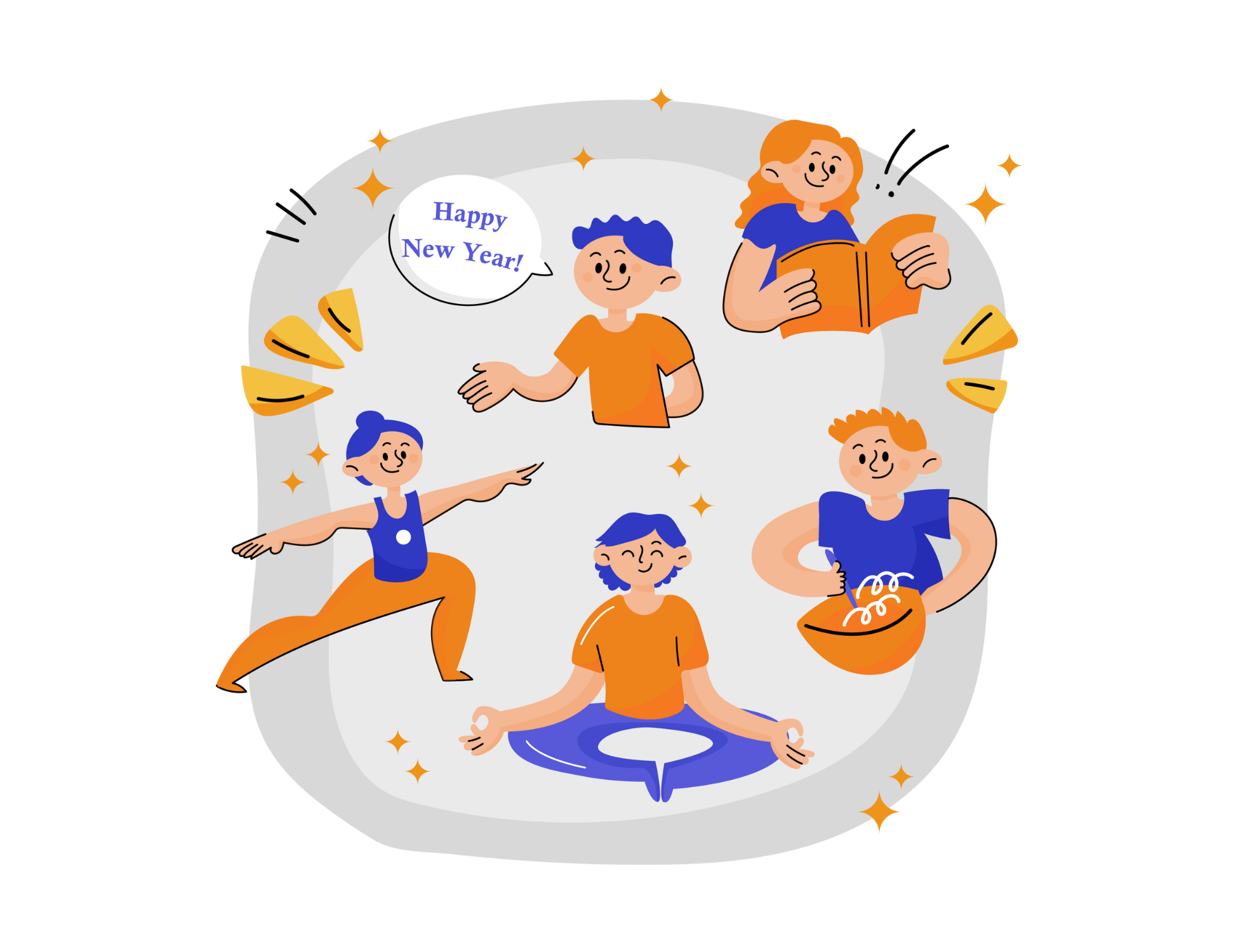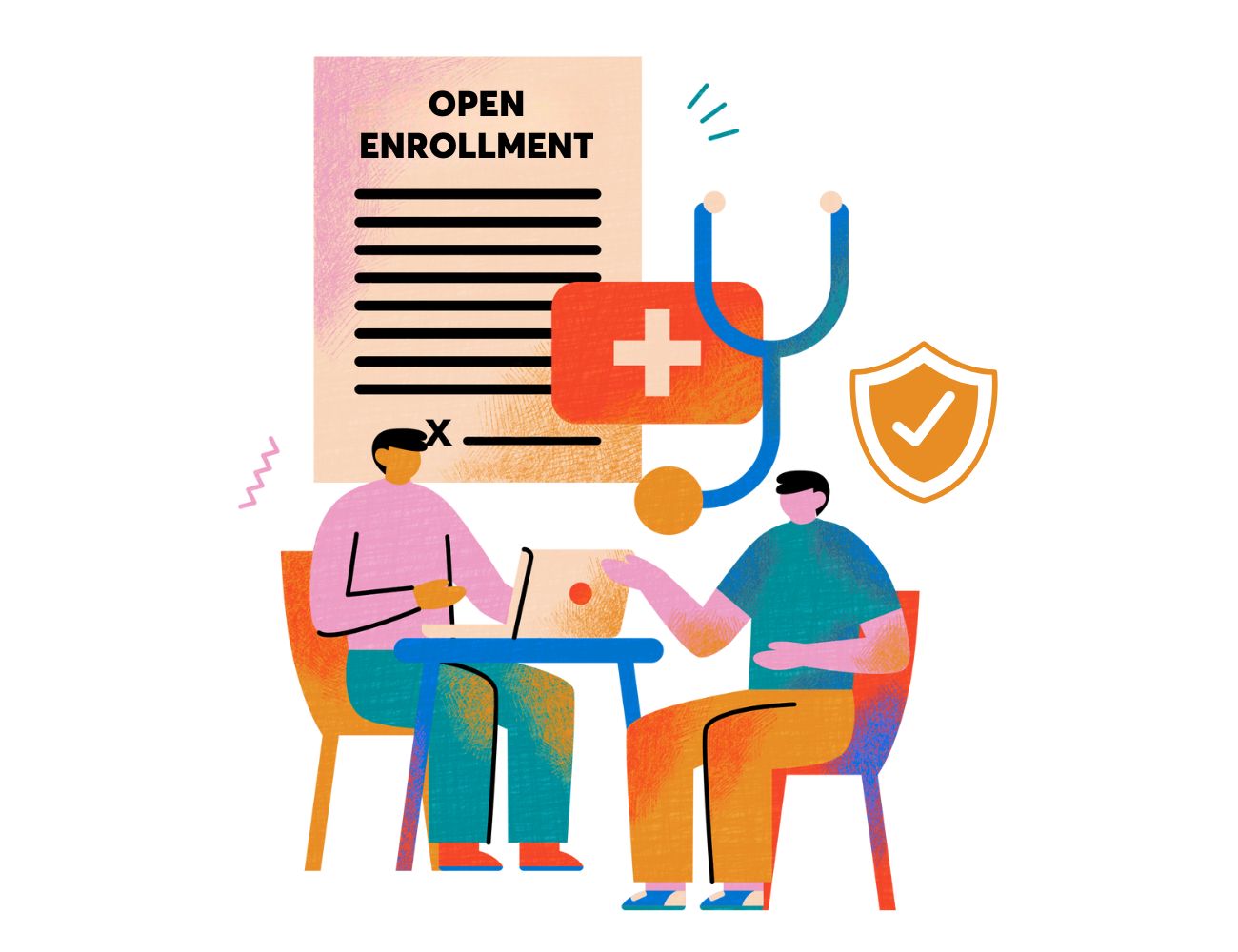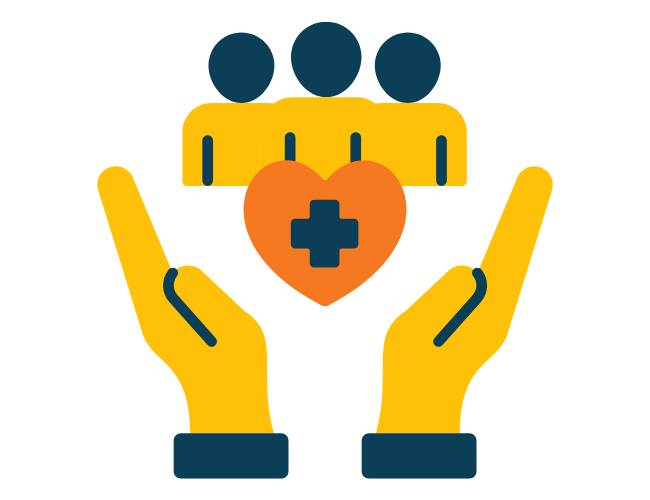An employee wellness plan, also referred to as an employee wellness program or well-being program, is a coordinated set of initiatives that helps staff lead healthier, more balanced lives. When thoughtfully designed, a wellness plan empowers teams to thrive and drives business outcomes like higher job satisfaction, increased engagement, boosted productivity, and reduced absenteeism and turnover.
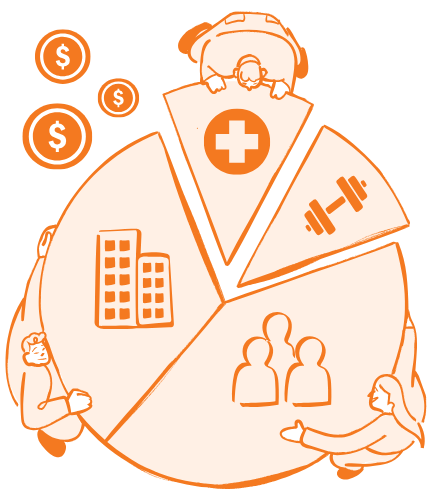
A strong wellness plan supports all aspects of employee wellness, from physical and mental health to social and financial well-being. While traditional health care is an important element, it is just one small piece of the wellness plan puzzle. Research shows that when employers broaden their programs to include financial, physical, and mental wellness initiatives, they see employee productivity, stress, morale, and creativity improve by 36% or more. This kind of holistic approach requires intentionality to address the core of well-being at work, but it doesn’t have to come with a hefty price tag.
It’s entirely possible to create a budget-friendly wellness plan that meets employee and business needs. Whether your organization is in a growth phase or facing economic uncertainty, you can leverage existing resources and embed wellness habits into workplace culture to build impactful programs without overspending.
Understand Your Team’s Needs
To understand how to make a budget-friendly wellness plan, it’s important to first assess organizational needs. There are a variety of ways to gather employee input and uncover wellness-related interests. Establishing this baseline helps manage costs from the start and ensures you’re investing in initiatives with the greatest potential for engagement, reducing the risk of wasting resources.
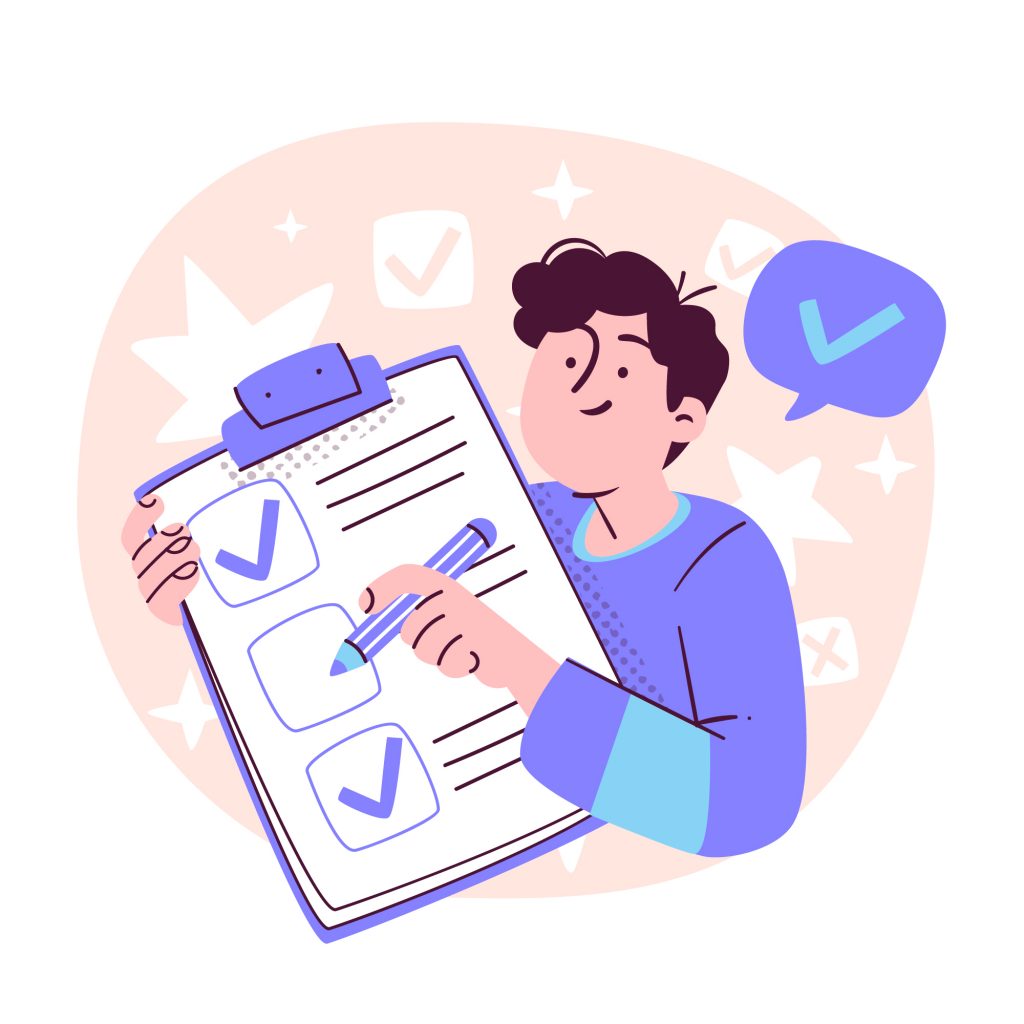
- Surveys: Create an anonymous pulse survey that allows employees to share their health goals and what type of wellness activities or topics they are most interested in.
- Focus groups: Invite team members to join a focus group where they can discuss health-related interests or concerns and help shape the company’s wellness plan with firsthand insight.
- Personal wellness assessments: Provide employees with a thorough health and well-being assessment that accounts for multiple wellness dimensions like physical, emotional, social, intellectual, occupational, environmental, and spiritual.
Set Clear and Measurable Goals
Once you have identified your organization’s core wellness needs, the next step is to define clear, measurable goals to achieve them. These goals help maintain focus, guide decision-making, and provide meaningful benchmarks for tracking progress and evaluating success over time.
A helpful framework for effective goal setting is the SMART goal method. SMART goals ensure that your wellness initiatives are actionable and aligned with broader business objectives and values.
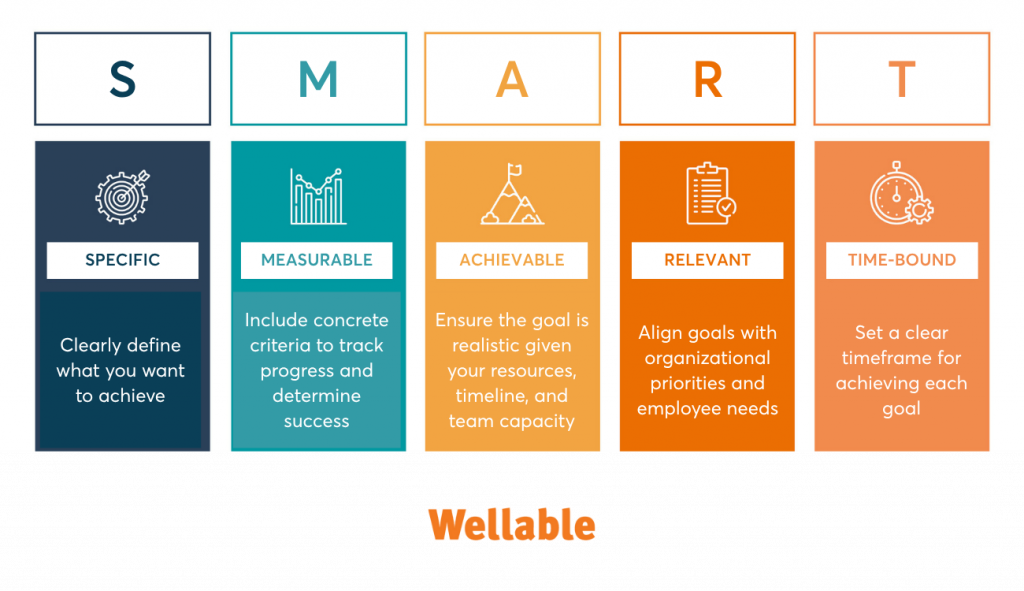
SMART Goal Examples for a Budget-Friendly Employee Wellness Plan
- Achieve 75% engagement in monthly wellness challenges for the first two quarters.
- Improve average nutrition tracking by 15% through wellness app use by the end of the year.
- Offer two new mental health education webinars every quarter and achieve an average of 65% attendance.
Whether focusing on health outcomes or program engagement, setting SMART goals helps demonstrate impact and guides continuous improvement of the wellness plan.
Budget-Friendly Wellness Ideas to Get Started
Based on organizational needs, start gathering a list of budget-friendly wellness initiatives with low-lift implementation. The following ideas support various dimensions of employee health and well-being.
Physical Activity

- Step tracking challenge: Gamify the experience by creating a leaderboard to track employee progress.
- “Take The Stairs” campaign: Post motivational signs near elevators that encourage employees to take the stairs.
- Walking meetings: Implement walking meetings as best practice for one-on-ones, brainstorming sessions, or other meetings that don’t require a computer.
- Walking groups: Encourage employees to walk together during lunch or take breaks for social movement.
- Free fitness bulletin: Determine an area (e.g., whiteboard, central digital space) where employees can post about local free fitness classes. Many studios and recreation centers offer weekly no-cost experiences.
- Fitness buddy program: Match employees together to motivate each other to stay active.
- Chair yoga sessions: Host virtual or in-person guided chair yoga using existing free online content or internal facilitators.
Nutrition

- Healthy food options: Stock the office kitchen with fresh fruit, vegetables, nuts, or protein-rich snacks.
- Meal prep Mondays: Share meal prep tips or recipes via email or messaging platforms to help employees plan more thoughtful meals.
- Snack swaps: Provide a list of simple swaps (e.g., almonds instead of chips) and encourage employees to try one each week.
- Recipe round-up: Create a shared digital space or bulletin board where employees can post their favorite healthy recipes.
- Weekly nutrition tip email: Send employees short, digestible nutrition facts or hacks every week.
- Registered dietitian Q&A: Host a virtual “Ask Me Anything” session with local dietitians, some of whom may offer complimentary sessions.
- DIY or virtual smoothie bar: Set up a build-your-own smoothie bar or host a virtual smoothie-making demo.
Mental Health
- Mindful minutes: Start or end meetings with one to two minutes of deep breathing or silence.
- Gratitude wall or channel: Designate a space for employees to post what they’re grateful for (publicly or anonymously).
- No-meeting hours: Choose a recurring time for uninterrupted focus or rest (e.g., Friday afternoons or 4 PM to 5 PM daily).
- Digital detox challenge: Encourage employees to unplug for a set period and reflect on how it affects their mood or focus.
- Guided meditation sessions: Offer free or volunteer-led sessions using apps or online content.
- Mental health book or podcast club: Choose accessible reads (e.g., Dare to Lead by Brené Brown, Unwinding Anxiety by Judson Brewer) or podcast episodes that promote personal growth and invite group discussion.
- Mental health resource hub: Create a central digital or physical space with links to hotlines, articles, apps, and free tools.

Career Development
- Monthly learning hour: Set aside one or two hours a month for employees to share skills or attend a free webinar, class, or workshop together.
- Success wall: Celebrate team and individual achievements with a physical or virtual board to boost morale and visibility across the organization.
- “Lunch-And-Learn” series: Invite employees or local experts to host quick sessions on career or wellness topics. Remember to record sessions for later viewing.
- “Ask Me Anything” with leadership: Provide transparent organizational insight with informal Q&As led by managers or executives.
- Internal job shadowing: Coordinate short-term “shadow” sessions for cross-functional learning and career exploration based on employee interest.
- Work anniversary celebrations: Acknowledge milestones with personalized notes, gifts, or small perks that show appreciation for employee dedication.

Financial Wellness
- Monthly money tips: Send out quick, digestible tips via email or messaging platform covering topics like saving, investing, budgeting, debt, and more. Find credible information on sites like the Consumer Financial Protection Bureau or the National Endowment for Financial Education.
- Budget templates: Provide downloadable budgeting spreadsheets that employees can personalize.
- Student loan education session: Invite an expert (or find one with video content online) to discuss repayment strategies.
- Credit card pay-off workshop: Host a workshop to teach common debt payment approaches (e.g., snowball method).
- Mindful spending tracker: Create and distribute a physical or digital worksheet that encourages employees to reflect on their daily spending.
- Budgeting 101: Provide resources for budgeting or host a lunch-and-learn to present helpful information like the 50-20-30 rule.
- Subscription audit: Help employees identify monthly subscriptions that typically go unnoticed. Make it a challenge, give a step-by-step guide, or refer people to apps that offer a free feature that identifies recurring charges.
- Financial wellness hub: Create a central digital or physical space where resources and event information can live.

Leverage Existing Resources for Your Wellness Plan
There are plenty of free resources and toolkits to support a budget-friendly wellness plan. These materials are ideal for sharing in company forums and newsletters or repurposing for lunch-and-learns and wellness events.
Government Toolkits
Find a variety of free evidence-based content on .gov sites like the National Institute for Health (NIH) or the Centers for Disease Control and Prevention (CDC). These organizations offer comprehensive toolkits on diverse wellness topics like workplace stress, physical activity, nutrition, and tobacco cessation.
Nonprofit Resources
Discover extensive employer resources and educational content on non-profit sites like Mental Health America (MHA) and American Heart Association (AHA), including mental health screenings, nutrition information, cooking tips, and warning signs of serious health conditions.
Free Webinars
Engage teams with free virtual events from wellness nonprofits and professional associations, covering topics like stress management, financial wellness, and more. Money Management International and National Alliance on Mental Health are a few examples with on-demand watch options.
Local Partnerships
Explore partnership opportunities with local hospitals, clinics, and community centers (e.g., YMCA) for wellness classes and events. These organizations often offer free or low-cost programs and may extend discounted rates to corporate teams.
Offer Incentives (Even Free Ones)

Encourage wellness plan participation with creative, low-cost rewards. Beyond incentivizing program involvement, rewards and recognition can boost employee morale and foster a greater sense of purpose at work. Below are some creative incentive ideas to get started.
Recognition in Internal Communications
Celebrate employees who complete wellness program milestones (like a step challenge or stress management course) in a company-wide newsletter or messaging platform.
Extra Time Off
Offer an afternoon or entire day off to employees who consistently engage with wellness initiatives, whether it’s attending webinars or completing health assessments.
Team-Based Point Systems
Reward departments or groups for collective wellness program participation with points that contribute to team lunches, company swag, or donation matching.
Wellness-Related Raffles
Enter participants into monthly raffles when they complete wellness program activities. Prizes can be wellness-focused items like yoga mats or events such as a cooking class or spa treatment.
Peer-to-Peer Recognition
Let employees nominate coworkers who have inspired or encouraged others with their wellness program involvement. Offer a trophy, special parking spot, or other reward for frequently recognized team members.
Healthy Doesn’t Have to Mean Expensive
Building a successful employee wellness program doesn’t require a large budget or elaborate programming. With thoughtful planning, creativity, and commitment to holistic employee well-being, organizations can offer customized, sustainable programs that make a real impact. From repurposing free, high-quality resources to adopting daily wellness-focused practices—like flexible work schedules and healthy office snacks—there are countless ways to support a lasting culture of workplace wellness on a budget.





